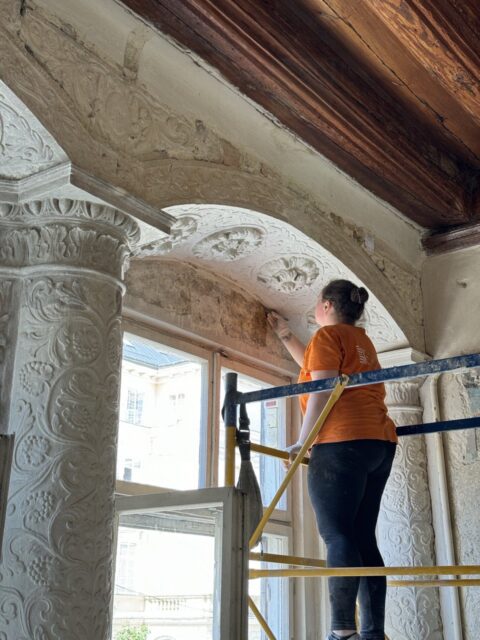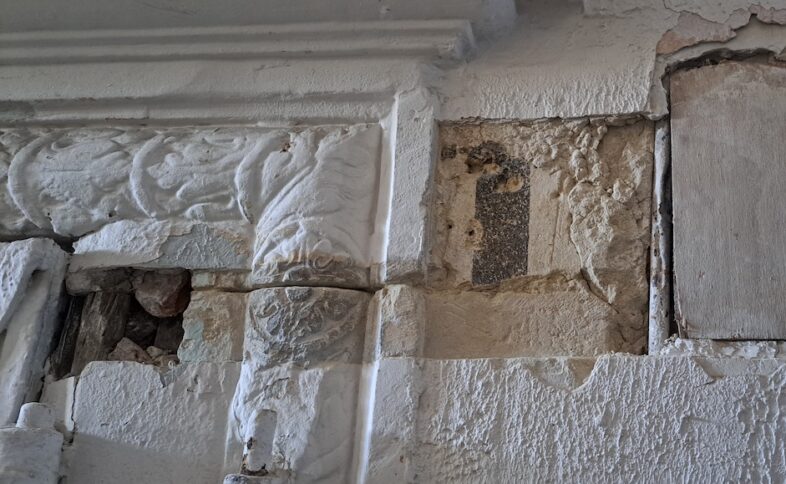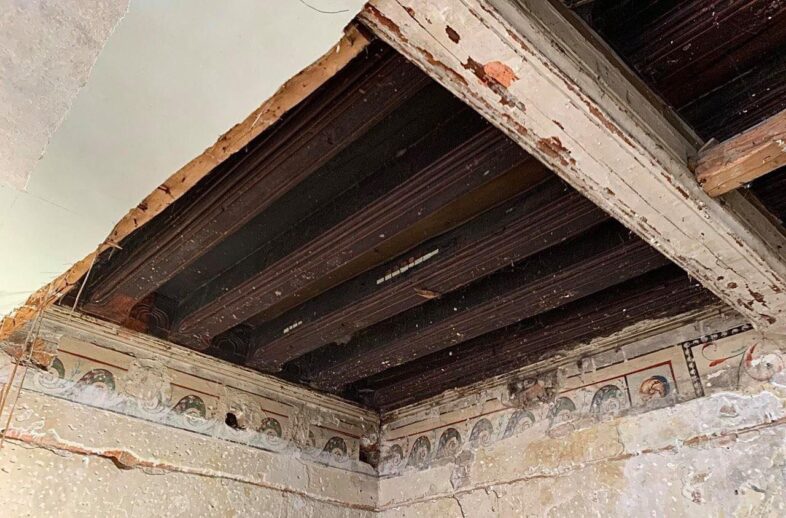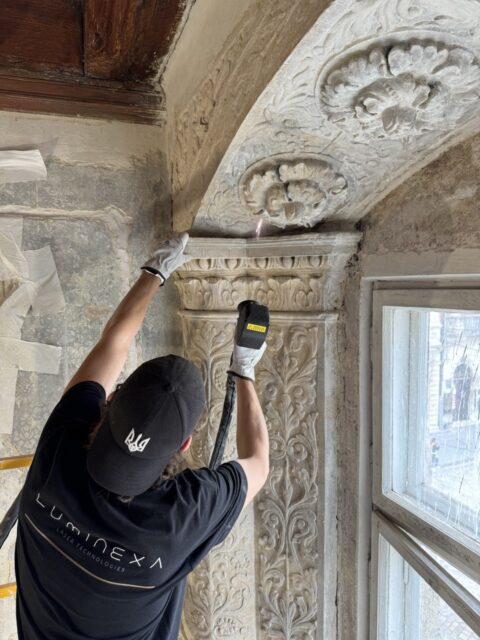Before our conversation, Vasyl Karpiv, a Ukrainian restorer and founder of the KARP Restorer bureau, guided me through the historic centre of Lviv, showcasing the buildings his team is currently restoring or has completed for their clients. He believes that one must first witness the principles he advocates in action. While I had previously explored the walls of the newly inaugurated Patyk Museum, admired the restored interiors and portals at both locations of Ya Gallery and the Art Library, and enjoyed a drink at a quaint bar with a spiral staircase leading to the second floor, this visit allowed me to appreciate his work up close. As I strolled through the streets of Odesa and Kyiv—cities that could greatly benefit from the restoration innovations introduced by Vasyl and his colleagues—I couldn’t help but reflect on the fragments of this revitalized aesthetic memory. The significance of his efforts became all the more apparent.
– Why is restoration important during the war when some might argue that rebuilding is a higher priority?
– I arrived in Lviv in 2002, intending to enrol at Trush College [Lviv State College of Decorative and Applied Arts named after Ivan Trush – ed.], initially captivated by the idea of studying metalwork. However, I was offered a course in restoration instead, pushing me into an unfamiliar field. To my surprise, as we delved into the study of different types of wood, I realised I had a strong background in this area, having grown up surrounded by forests. Since then, Lviv has become my home, though, since the full-scale invasion, I’ve moved to a village near the woods, commuting daily to the city for work.
My first impressions of Lviv were indelible; I wandered its streets with purpose, attentively noting the intricate details of its walls, windows, doors, and cobbled paths. In 2011, a grant allowed me to study in Poland, where I fortuitously encountered one of the foremost experts in restoration. His mentorship provided me with a clear vision of the path I needed to pursue upon my return to Ukraine.
– Throughout your work on various projects, have your perspectives on restoration evolved? What about regulations, technologies, or creativity?
– Restoration is akin to medicine in that it encompasses both regulations and technologies. Our goal is to prolong the life of buildings. The tools, research methods, and equipment we employ closely resemble modern medical practices; in fact, we borrow techniques from the medical field, utilising X-rays, scalpels, syringes, and even advanced lighting systems. We also harness physical and chemical innovations.
However, there is a prevailing belief that restorers are merely artists, as the lines between repair, restoration, conservation, and design often blur. While these are distinct professions recognised in Ukraine, for many, they all fall under the umbrella of simply “making it look nice.” So, how can we, as KARP Restorer, shift this perception? We’ve initiated a project that illustrates the various stages of transformation, typically for private clients. This approach not only raises awareness but also fosters informed discussions about specific issues within the field.

Photo: Diana Klochko
– Is there a house (or any site) that you have restored or preserved that has become a source of quiet pride for you?
– That’s a tough question, as none of our major restoration projects are complete yet, which means they can’t be showcased as finished cases. However, I take great pride in the facade at 6 Virmenska Street when it comes to exteriors. As for interiors, 17 Virmenska stands out: there, we’ve conducted extensive clearing and research on historically significant elements. I once brought a colleague specialising in history to this site, and upon seeing one of the beams where the initials of the owner’s family had been uncovered, she exclaimed, “I read about the Eminovych family in the Vatican’s scientific library!” To witness a house in Lviv that belonged to a family one has encountered in the Vatican—that’s truly remarkable. It encapsulates the essence of the restorers’ work and the importance of conserving historical layers. We are currently involved in an exciting project in Zakarpattia, focused on researching churches from the Gothic and Renaissance periods.
– The Horian Rotunda?
You may be familiar with one of these churches, but there are several more equally captivating examples that remain unlisted as state-protected monuments. Recently, the Hungarian László Teleki Foundation invited me to study five such sites, each boasting remarkable frescoes that will soon be revealed to the Ukrainian public. You can view them here.
– In Lviv and Zakarpattia, there are individuals who recognise the value of restoration in revealing, researching, conserving, and documenting various historical and stylistic layers. How do you collaborate with designers who incorporate modern elements into these historical contexts? Do you face any challenges in this process?
– Challenges frequently arise in our field, particularly when designers enter the conversation with little regard for the nuances of our restoration work. It often begins with a sweeping directive: “This all needs to be painted.” Typically, it’s Volodymyr Kostyrko who steps in to navigate these discussions, armed with compelling arguments against altering the integrity of the structure. Over time, however, we work towards a consensus that allows for a harmonious coexistence of historical and modern elements.

Photo: Diana Klochko
– When it comes to the colour schemes adorning the facades in Lviv’s city centre—vibrant, tourist-centric hues crafted to attract attention for social media snapshots and marketing campaigns—this trend took root in the early 2000s. Yet, as we witness a shift towards a more authentic approach to restoration, one must question whether this cheerful polychrome should be stripped away in favour of a more historically resonant palette.
– Indeed, there is a pressing need to investigate the oldest layers of polychrome and rethink our colour schemes entirely. Most of Lviv’s facades are in relatively poor condition, leading to an urgent desire to refresh them quickly. The prevailing aim often seems to be to transform Lviv into a mirror image of Vienna; yet, during my last visit to Vienna, I couldn’t help but notice that it was beginning to resemble Lviv instead!
Historically, Europe has embraced vibrant colour in its urban landscapes, contrasting sharply with the drab uniformity of the Soviet era, where grey dominated, and the occasional peach hue was considered daring. Throughout Europe, facades burst with natural colours that the eye finds soothing and familiar. However, the modern chemical industry has introduced shades engineered for stark contrasts and high saturation, which can sometimes convey a particular ideology about how contemporary objects exist within their surroundings.
Consider, for instance, the unfortunate scenario when someone acquires a bulk of bright lime-green paint at a discount from Epicenter, having won a tender based on the lowest bid, only to plan a garish transformation of the town hall in Mukachevo. This results in a colour palette reminiscent of a Barbie dreamhouse, detracting from the historical integrity of the environment.
So, what truly distinguishes restoration from mere repair? We meticulously study the structure to ensure that any additions are made using original pigments and materials. If we uncover red ochre, then that is precisely what should be employed—not a synthetic salmon pink. Ironically, natural paints are readily available in Ukrainian building stores and are often cheaper than their synthetic counterparts. Therefore, why not use these natural pigments to recreate the original shades? This should be the essence of colour reconstruction—grounded in authenticity rather than merely catering to the Instagram aesthetic.

Photo: Diana Klochko
– If we were to envision a remarkable transformation of Lviv’s historic centre, restored with the latest research and conservation technologies, which era would you aim to ‘return it’ to?
– That’s a complex question. We evaluate each object on an individual basis, prioritising the style that is most predominant. For example, there may only be a few square centimetres of Renaissance frescoes remaining, while extensive sections of Classical stucco and plaster dominate the surfaces. Our task is to find a way to harmoniously integrate these elements, removing layers of Soviet-era repairs in the process. It requires a ‘concilium’—returning to the medical metaphor once again. To ensure that certain layers remain accessible in the digital realm after being covered by restorations, we meticulously document everything through photographs and 3D scanning.
Lviv is a tapestry of European architectural styles: Gothic elements tucked away in the basements; Renaissance features that grace the portals and windows; Mannerist embellishments in the décor; Baroque frescoes adorning the walls; and the sophisticated lines of Rococo, Classicism, Historicism, Eclecticism, Secession, and Art Deco—all coexist as cohesive structures. Notably, Renaissance or Baroque portals may be nestled within 19th-century additions, framed by Eclecticism, which is now often regarded as a conventional style in its own right. Our mission is to preserve these layers, however fragmented, ensuring that the building’s history is visually articulated in its façade.
In sacred architecture, this evolution is more apparent, as churches often expanded over time, while private townhouses were modified according to the aesthetic preferences of their owners across centuries. We cannot simply revert to a singular period or style; all the subsequent additions—often several storeys high—are integral to the ensemble of forms. However, we can unearth specific elements, allowing the building to reveal its architectural narrative to the discerning observer rather than conceal it.
– And what about interiors? What styles can be revealed within them?
– The same styles as those found on the façades. We encounter Renaissance elements, such as beamed ceilings and intricately sculpted portals, alongside a rich array of plasterwork and murals spanning from Baroque to Secession, with a wealth of examples to explore.
– Are these interiors mostly public spaces or private homes?
– One notable example involves a young man from Los Angeles who purchased an apartment adjacent to the Korniakt Tower. His vision was to preserve all the stylistic elements, even retaining the Soviet-era “straw” parquet, which we removed and stored in the attic. Beneath it, we uncovered an exquisite parquet laid by the Austrians. He aspires to live in a historically rich environment, blending styles from the 16th century with original Andy Warhol prints and contemporary furniture. Although the war has postponed the final furnishing, the project remains intact.
– During the war, you’ve really embraced new technologies. I saw for myself how a neglected 19th-century villa was transformed into the stunning interior of the Patyk Museum. You and your team used lasers to clean the stone, wood, and façades in just two months.
– What once required complex chemical solutions can now be accomplished much more quickly and in an environmentally friendly way with laser technology. Such innovations greatly expedite conservation and restoration efforts, but they necessitate a high level of education and expertise.
– Should a restorer ever remove the patina of time just for aesthetic reasons or to fit a specific project?
– Every art object is unique, be it a painting or a building. A restorer must never compromise the value of the original; their role is to preserve the object’s integrity rather than alter its image. However, in Ukraine, the prevailing attitude has often been quite the opposite.

Photo: Diana Klochko
– Have you seen the Horodetsky House in Kyiv? [The “House with Chimeras,” designed and built by architect Vladyslav Horodetsky in 1903, underwent its most recent reconstruction, which included re-equipping the premises for events involving the President of Ukraine, and was completed in 2004 – ed.] Is that the kind of restoration you mean?
– I find myself feeling quite uneasy in Kyiv; the once distinctive plasticity of the facades has been obscured by multiple layers of paint, erasing their historical authenticity. If we could strip away the various renovations to reveal the original colours and restore the buildings to how they appeared in the early 20th century, it would transform their character entirely. As it stands, they present as mere silhouettes with uniform, dulled colours that reveal more dust than paint. There is potential for restoration, and the research could serve as an engaging case for Kyiv residents, illustrating how to remove the artificial layers of the Art Nouveau era and reclaim the city’s architectural heritage.
– How much of this will remain as mere façade instead of undergoing proper restoration after the Russian-Ukrainian war ends?
– That’s a crucial question. Across Ukraine, we have only five monumental art restorers who can work effectively. While there are more individuals in the field, the term “restorer” encompasses various specialisations, including stone restorers, monumental and easel painters, and those who focus on paintings, icons, paper, and textiles. Currently, I’m part of a commission collaborating with the Ministry of Culture to establish guidelines for documenting damage to cultural heritage objects and their restoration. Our approach follows a systematic scheme of research, conservation, restoration, documentation, and fixation. We are also working on setting up an oversight body to monitor restoration and conservation projects. This would empower me to intervene on-site and halt any work if I observe violations. However, it’s important to note that we won’t be able to cover every village and town, as there simply aren’t enough specialists in Ukraine. To address this gap, Troupe College and the Lviv National Academy of Arts have initiated a course on “Monumental Art Restoration,” with a similar programme offered at Lviv Polytechnic National University. This foundational training spans six years, incorporating practical experience with real objects.
– How many specialists are needed across Ukraine?
– We need dedicated departments for monumental art in cities like Kyiv, Odesa, Uzhhorod, and Kharkiv, ideally with ten to twenty restorers in each from the outset. These professionals should focus on preserving monumental art and managing buildings in a comprehensive way. Each historical period contributes its unique artistic and aesthetic value to our cities, so it’s essential to regularly study, conserve, restore, and protect these individual objects. A robust education and practical training system is crucial for this effort.
Much like doctors save lives, restorers have the power to preserve our cities by recognising their historical significance. We must establish a system ensuring that funds allocated for restoration are not simply spent on superficial repairs. Initially, it might be beneficial to form large international teams, allowing European specialists to engage with our challenging projects while Ukrainians learn alongside them.

